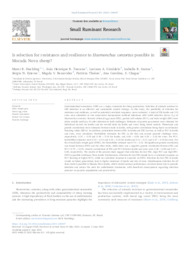Is selection for resistance and resilience to Haemonchus contortus possible in Morada Nova sheep?
Is selection for resistance and resilience to Haemonchus contortus possible in Morada Nova sheep?
Autoria: HAEHLING, M. B.; TOSCANO, J. H. B.; GIRALDELO, L. A.; SANTOS, I. B.; ESTEVES, S. N.; BENAVIDES, M. V.; THOLON, P.; CHAGAS, A. C. de S.
Resumo: Gastrointestinal nematodes (GIN) are a major constraint for sheep production. Selection of animals resistant to GIN infection is an effective and sustainable control strategy. In this study, the possibility of selection for resistance and resilience, as well as potential correlated responses, were evaluated. A total of 256 lambs and 123 ewes were submitted to two consecutive independent artificial infections with 4,000 infective larvae (L3) of Haemonchus contortus. Records of faecal egg count (FEC), packed cell volume (PCV), and body weight (BW) were taken serially until day 42 after infection in both challenges. Estimates of genetic parameters were obtained for individual records (in lambs) and for overall traits (in lambs and ewes) using mixed models. Phenotypic and genetic correlations were estimated between traits in lambs, with genetic correlations being based on estimated breeding values (EBVs). In addition, correlations between FEC in lambs and FEC in ewes, as well as PCV in lambs and ewes, were calculated. Heritability estimates for FEC in the first and second parasite challenge were, respectively, 0.25 ± 0.18 and 0.46 ± 0.19 for lambs, and 0.00 ± 0.09 and 0.20 ± 0.16 for ewes. For PCV, heritability estimates were 0.23 ± 0.14 and 0.32 ± 0.16 for lambs and 0.13 ± 0.11 and 0.37 ± 0.18 for ewes. For the overall daily weight gain (DWG), the heritability estimate was 0.70 ± 0.21. No significant genetic correlation was found between DWG and the other traits, while there was a negative genetic correlation between FEC and PCV (-0.70 ± 0.03). Genetic correlations of FEC and PCV between lambs and ewes were 0.36 ± 0.08 and 0.42 ± 0.08, respectively. The results of the present study suggest that selection for low FEC, high PCV and high BW/DWG is possible in Morada Nova lambs. Furthermore, selection for low FEC should have a correlated response on PCV (leading to higher PCV), while no correlated response is expected on DWG. Selection for low FEC in lambs would, in future generations, lead to higher resistance of lambs and also of ewes. Simultaneous selection for all three traits is possible in Morada Nova lambs, which would increase performance, decrease losses due to parasite infection and reduce the need for anthelmintic treatments, with beneficial consequences regarding selection pressure on parasite populations and productivity.
Ano de publicação: 2021
Tipo de publicação: Artigo de periódico
Unidade: Embrapa Pecuária Sudeste
Observações
1 - Por padrão são exibidas publicações dos últimos 20 anos. Para encontrar publicações mais antigas, configure o filtro ano de publicação, colocando o ano a partir do qual você deseja encontrar publicações. O filtro está na coluna da esquerda na busca acima.
2 - Para ler algumas publicações da Embrapa (apenas as que estão em formato ePub), é necessário ter, no celular ou computador, um desses softwares gratuitos. Sistemas Android: Google Play Livros; IOS: iBooks; Windows e Linux: software Calibre.
Acesse outras publicações
Acesse a Base de Dados da Pesquisa Agropecuária (BDPA) para consultar o acervo completo das bibliotecas da Embrapa.

